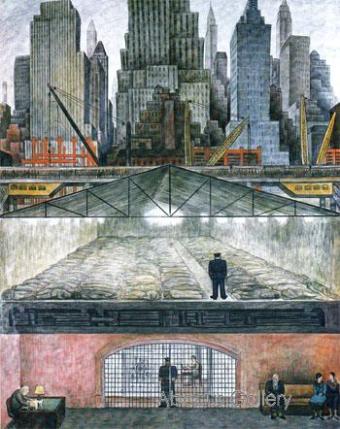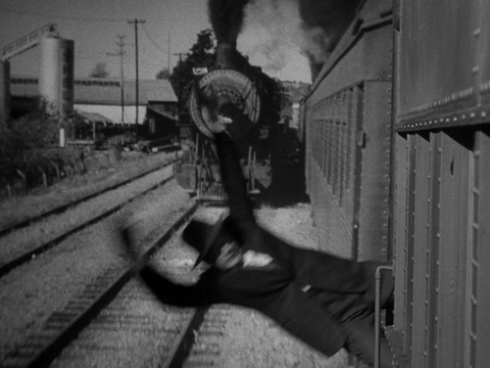Alfred Hitchcock’s prescient 1943 film, Shadow of a Doubt, uses iconographic and dialogical cues to capture nihilistic notions of urban life and capitalism’s penchant for social decay echoed by historians like Lewis Mumford. In 1961, Mumford wrote, “…it is plain that never before in human history had such vast masses of people lived in such a savagely deteriorated environment, ugly in form, debased in content.” Coupled with powerful images of urban degradation, Hitchcock uses the character Charles Oakley, or Uncle Charlie to his family, as a vehicle for his social commentary.
Like Diego Rivera’s fresco mural Frozen Assets (1931-1932), Hitchcock begins his film with proletarian imagery in the foreground juxtaposed with symbols of capitalist conquests in the background. First, the panning camera shows the audience two expansive steel bridges over a desolate river while two shaggy men, seemingly on their lunch break, gape at two technological achievements before them: bridges and factories. That shot then dissolves into a shot of a mutilated automobile next to a “NO DUMPING ALLOWED” sign in the foreground with a sprawling city in the background. Progressively, the scope of the shots becomes smaller and smaller – showing a city, then a street, then a window – until it reaches the ruminative Charles Oakley (interestingly, who his maid calls “Mr. Spencer”) in a cadaver-like prone position.
Uncle Charlie’s past and future is particularly suggestive of his role as the urban nihilist. His sister, Emma Newtown, tells her daughter, young Charlie, the story of the childhood incident which dramatically changed Uncle Charlie’s personality: while riding his bicycle, Uncle Charlie was struck by a car. In this context, the car symbolizes capital expansion, technological advancement, and affluence of which Uncle Charlie’s trauma thenceforth leads him to become the man who claims, “Forty thousand dollars is no joke, not to him, I bet. It’s a joke to me. The whole world’s a joke to me.” He nostalgically reminisces about how perfect the world was in 1888 and curses his contemporaneous surroundings; ultimately, however, it is his surroundings which curse him.
His death comes by two meaningful symbols: a female and a train. The train is the great technological symbol of capitalism and, at the time, provided the arteries for the country’s pulsing economic heart. On the other hand, Charlie Newtown (the symbolism of whose full name should not be overlooked) is the foil and defeater of misogynistic Uncle Charlie. Sexism though is a topic in this film which should be exclusively discussed at length in another essay. For the focus and purposes of this essay, I will simply remark that it has significant symbolic meaning. Her name, however, contains manifold implications. Her first name is curious for two reasons: of course, it is the same name as her uncle which seems to mean that she is supplanting him to some extent and, also, it is an androgynous name. Her last name, Newtown, appears to be Hitchcock’s way of foreshadowing the urban flight to the suburbs. Uncle Charlie’s death marks the end of the end of the urban locus and Charlie Newtown represents America’s social, cultural, and geographic future.
There is too little space in this blog for so much meaning in this film.




Michael,
You have chosen an exceptionally rich topic for this post: the capitalist critique underpinning Hitchcock’s thriller Shadow of a Doubt. You do an excellent job–in the space you’ve allotted yourself–of exploring this topic. Your analysis of the opening shots of the film is both well-written and persuasive; I especially like that you draw in other relevant sources (both historical and aesthetic) to substantiate your claims. I also agree with your interpretation of the significance of the two vehicles that strike Uncle Charlie. As you point out, cars and especially trains stand as symbols of capitalist power and expansion. That said, while we might attribute Uncle Charlie’s deterioration to his childhood accident (with all its attendant symbolism), I wonder what you make of his career as a (quite capitalistic, enterprising, and successful) serial killer. This is one point I think you could develop further.
I agree with your final comment–there’s not enough space! You should consider expanding this post for your formal paper (due towards the end of the semester).
Great job,
MT